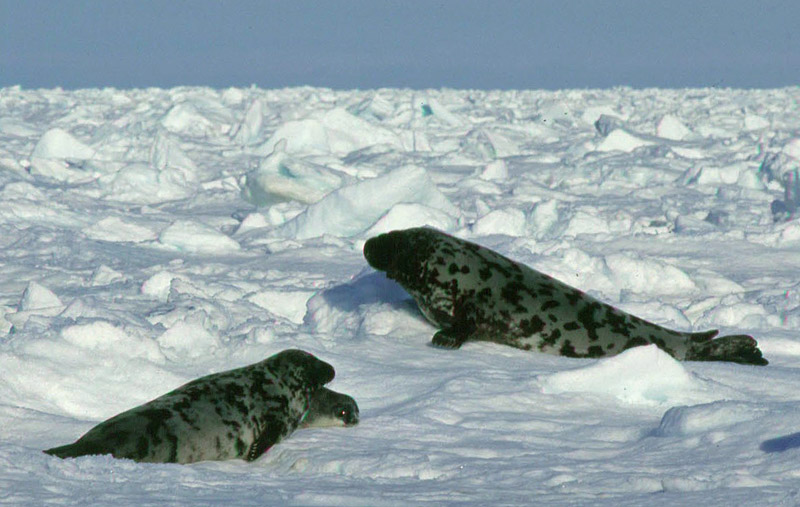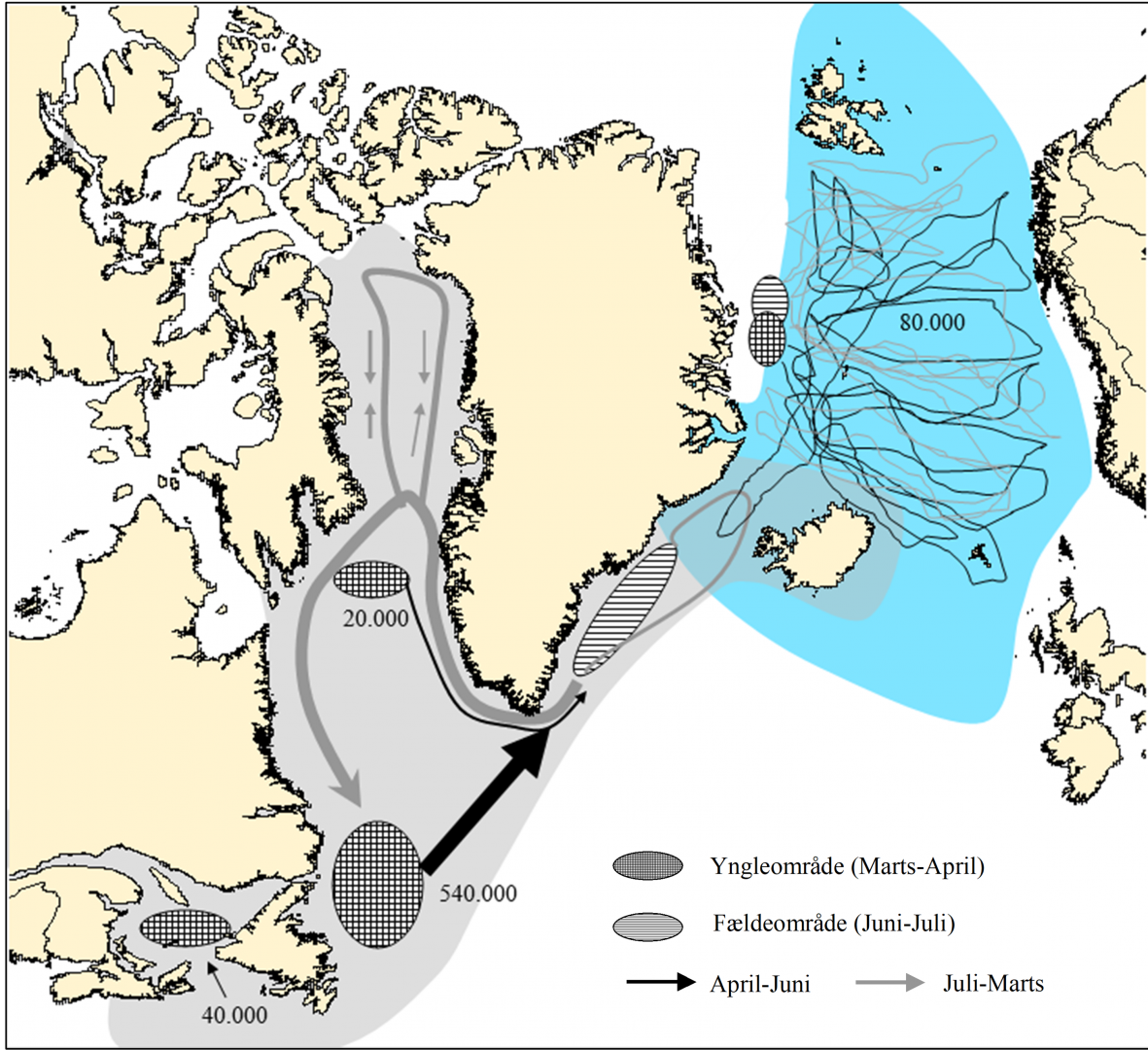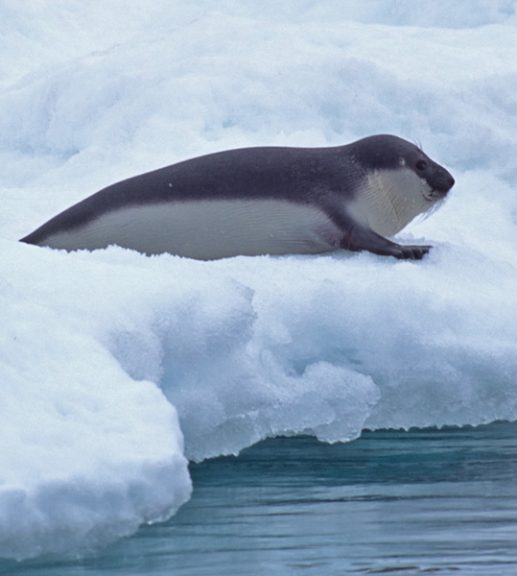Hooded seal
Cystophora cristata

The newborn hooded baby only sucks for approx. 4 days. Mating takes place immediately after the lactation period, and often there is a male who waits for the female to be ready for mating. His place will be challenged by other rival males. Photo: Aqqalu Rosing-Asvid.
Size
The hooded seal is a large seal. Fully grown, the females measure approx. 2 meters, while fully grown males average about 2.60 meters. The males become significantly more powerful and heavier than the females. The hooded seal is thinnest immediately after it has shed its fur in July. At that time, a fully grown female will weigh between 150-200 kg, while fully grown males weigh 250-300 kg. During the winter, they will weigh up to 50% more than their summer weight, so the largest females weigh up to 300 kg and the largest males can weigh up to 450 kg.
Food
The hooded seal eats most of its food in the outlying areas and not much is known about what it eats out there. But in the coastal areas, the hooded seal often eats large fish such as, halibut, redfish and cod, as well as squid. Studies of the fatty acid composition of the hooded seal show that the golden salmon (argentina silus), a large shoal fish that lives in deep water in most of the hooded seal’s distribution area, is also an important food item.
Reproduction
Like the other Greenlandic seal species, the hooded seal usually becomes sexually mature around the age of five (some 1 to 2 years sooner or later). During the winter, the adult hooded seals congregate in specific areas where they give birth to their young (see distribution and number). Most hooded seals are born in the second half of March, but births can occur from early March to early April. The cubs are at birth approx. 1 meter long and weighs between 23-30 kg. The lactation period is only approx. 4 days, and the pups gain no less than 7 kg per day during the period, so that they approx. double their weight. The mating takes place when the baby has finished suckling, and then the baby is left to fend for itself. After mating, the fertilized egg sometimes splits and goes to sleep. Only around the end of July or the beginning of August does the egg attach itself to the uterus (it is implanted) and fetal development begins.
Moulting
The hooded hats gather in June-July to shed (change hair). Flax, which breeds off Northeast Greenland, also fells off Northeast Greenland, while West Atlantic hooded seals gather on the ice near Ammassalik to shed.
Distribution and numbers

Breeding are (yngleområde). Moulting are (fældeområde).
Status
The figure shows the main distribution and main features in the migrations of the hooded seals. According to traces, the hooded seals that breed in the Greenland Sea will typically swim back and forth over the deep parts of the Norwegian Sea. The cubs will already a few days after birth start a migration pattern that is very similar to the adult seals. Traces of the western hooded seals show that, with the exception of a few detours, they follow a certain pattern. After the breeding season, they swim very purposefully towards their moulting area, which is the ice area in Southeast Greenland. On the way to this area, there are some who rest on the ice in Southwest Greenland, where spring hunting of hooded seals is important for some hunters. After moulting (late July-early August), they migrate up the coast of West Greenland, but this migration takes place offshore, and therefore goes almost unnoticed. There are three breeding fields for the West Atlantic hooded seals, and it is believed that there is some exchange, as the number of seals can vary on the three fields. In particular, the number of seals breeding in Davis Strait off Nuuk varies greatly from year to year. In 1984, 18,600 pups born in this area were estimated, but in 2005 the estimate was only approx. 3,350 kids. The number of yearlings usually makes up about 1/5 of the total population. The West Atlantic stock has not been counted since 2005, so the figures for this stock are old, but it is not expected that there will be fewer when the commercial hunting stopped after 1998. In the Greenland Sea, there have been counts in 2011, 2013, 2017 and 2019 and all times the estimate has been close to 80,000 hooded seals.
Status

Hooded seal yearling. Photo: Aqqalu Rosing-Asvid.
It is believed that the early commercial hunting at Newfoundland significantly reduced the stock. In 1918, the last large catch (35,000 hooded seals) was landed, and since then the catches have been relatively modest (except for a few years). In the early 1980’s, various management measures were taken to reduce commercial catches, and since 1993, commercial exploitation of the skin of hooded seals has been banned in Canada. The Canadian catch has been modest in the last decade (<80 hooded seals / year), while the Greenlandic catch has been in the order of 1500-2000 animals. The total catch is thus less than 1% of the stock, and with this relatively modest catch, it must be assumed that this stock of hooded seals has been increasing in number. However, there are no counts that can confirm or deny this.
The hooded seal population off Northeast Greenland was also greatly reduced by commercial hunting, especially in the years after World War II. The researchers’ calculations indicate that the current population is only approx. 10% of the level from before the commercial catch started. The commercial catch stopped in 2007 and was replaced by a scientific catch of a few hundred seals. In addition, catchers from Ittoqqortoormiit take a smaller number (usually less than 10 pcs / year). With such a small catch, this stock should also be growing, but it has not yet been possible to prove that this is the case. The counts since 2011 indicate that the stock is fairly stable at the current relatively low level.
Management
The status of hooded seals is assessed by an international working group under ICES / NAFO / NAMMCO, which advises administrations on quotas for commercial catches. The working group consists of researchers from Norway, Canada, Greenland and Russia.
Research
Counting hooded seals in the West Atlantic area is an expensive and extensive operation as these seals are spread over a very large area. Therefore, these counts stopped even after the commercial catch had been stopped. In the Greenland Sea, the births of harp seals and hooded seals overlap both in time and geographically, and therefore the two species can be counted simultaneously. The Norwegians still have a small catch of Greenland seals in the Greenland Sea, and the stocks are therefore regularly monitored. You can read more about how this is done in the section on harp seals.

